In the United States, there were Indian Boarding Schools that coerced and invited Native American parents to release their children into the system that would transform them into good little American citizens with such useful vocations as domestic and farm labor. Sometimes, school officials resorted to kidnapping when parents obstinately refused to hand over their children. From the government’s and schools’ perspectives, this was a tremendously good deal for those pesky Indigenous creatures, but for the Native children who suffered and survived the experience, it was anything but beneficial in many circumstances. Across the ocean, in Australia, the government and like-minded citizens did much the same thing to their aboriginal population from 1869 through 1970.
Rabbit-Proof Fence (2002), directed by Phillip Noyce, is a powerful and assertive film version of this tragedy. Based on three real-life indigenous survivors of this era, known collectively as the Stolen Generation, the film is set in 1931 and tells the story of three young girls who were kidnapped on the government’s authority, forced into an “aboriginal integration” program 1,200 miles from home, and who are determined to run away and make it home on their own by following the fence. Unfortunately, the school’s director hunts them with the veracity of an early 1800s US slavemaster. He is relentless and determined, but the girls are as well.
[youtube_sc url=”https://www.youtube.com/watch?v=Lbnk8wSVMaM&feature=kp”]
The film opens with a narrative voiceover in Aboriginal language by the real Molly Craig, describing what she sees from her perspective in the future: “This is a true story. Story of me, my sister Daisy and my cousin Gracie when we were little. Our people, the Jigalong mob, we were desert people then…walking all over our land. My mum told me about how the white people came to our country. They made a storehouse here at Jigalong…brought clothes and other things: flour, tobacco, tea. Gave them to us on ration day. We came there, made a camp nearby. They were building a long fence.”

The voiceover accompanies cinematic views of the desert landscape, bright sun, open land, and sky. These opening two minutes set the stage, the scene, and the perspective of the film. It is clearly the director’s intention for viewers to see this moment in history from the Indigenous peoples’ perspective and to understand that this type of thing really did happen. For anyone who dislikes boldly polemical films, this approach might be a turn-off, but I encourage you to stick with it. The story itself is moving and well-acted by all players. You will end up hating Neville, the government official granted guardianship of all Aboriginal peoples by the Aborigines Act, played by Kenneth Branagh, and you will root for the girls to succeed in their quest to return home. The villain in this film, and in reality, is the government and its racist policies.

Molly Craig (Everlyn Sampi), Daisy Craig Kadibill (Tianna Sansbury), and Gracie Fields (Laura Monaghan), are considered by the government to be “half-castes,” because they have white fathers. In the opening scene where the girls and their female elders are hunting iguana, the idyllic family scene is overshadowed by the presence of a white soldier and a white tracker, who identify the girls and ride past their outback home. The viewer is meant to feel the discomfort of being watched and cataloged. The scene then shifts to a neat, wooden-cabinet-lined government office where Neville calmly and dispassionately writes out the kidnap orders for Molly, Gracie, and Daisy.
With a bold stamp on the papers, Neville explains to his secretary these new orders:
“Now this report from Constable Riggs about the three little half-caste girls at the Jigalong. . .Molly, Gracie, and Daisy, the youngest is of particular concern, she’s been promised to a full-blood. I’m authorizing their removal. They’re to be taken to Moore River as soon as possible.”
And just like that, three girls’ lives are changed in abominable ways. Constable Riggs (Jason Clarke) arrives on ration day and chases the panicked and running girls with their mother with a car, threatening to lock the mother up if the girls don’t come with him. He forcefully pulls the fighting girls away from their screaming mother and pushes them into the back seat of his car. The girls and mother wail and scream as the solder drives the car away, leaving the older women moaning on the desert land. Affecting doesn’t begin to describe this scene, especially for any woman who is a mother. Just imagine your government coming after your child in this manner.

the Chief Protector of Aborigines.
Immediately following this scene, Neville is once again in a well-appointed room, showing photos to a group of white women who support the efforts of government-run Aboriginal integration schools such as Moore River, and explaining the rationale for the government’s racist policy of forced removal and education:
“As you know, every Aborigine born in this state comes under my control. Notice, if you will, the half-caste child. and there are ever-increasing numbers of them. Now, what is to happen to them? Are we to allow the creation of an unwanted third race? Should the coloreds be encouraged to go back to the black? Or should they be advanced to white status and be absorbed in the white population? Now time and again, I’m asked by some white men, if I marry this colored person, will our children be black? And as chief protector of Aborigines, it is my responsibility to accept or reject these marriages.” At this point in his speech, Neville changes the slide to an image of two women and a young boy before continuing.

“Here is the answer. Three generations. Half-blood grandmother, quadroon daughter, octoroon grandson. Now as you can see in the third generation, or third cross, no trace of Native origin is apparent. The continuing infiltration of white blood finally stamps out the black color. The Aboriginal has simply been bred out.. . .In spite of himself, the Native must be helped.”
Therein lies the reasoning behind Aboriginal integration in Australia.
At the Moore River school, where the girls are sent by Neville, the goals are integration into white society as domestic workers and farm laborers, removal of all Aboriginal language and culture from the children, and physical abuse to reinforce these goals.

the Moore River Native Settlement.
After the girls are fed and washed, they are given clothes. Gracie says to Molly in their own language, “New clothes!” The white female teacher leans down and says, “This is your new home. We don’t use that jabber here. You speak English.”
Downloadable clip from Australian Screen: Neville inspects Molly at Moore River.
After seeing a girl returned and punished for trying to escape, Molly lays awake at night thinking about how these people make her sick, and then she dreams of the spirit bird that her mother told her would always guide her. The next day, while everyone is at church, Molly watches from the dormitory doorway as a thunderstorm growls on the horizon. In this moment, she makes a decision. She turns back to Gracie and Daisy, who are on the bed, and says, “Come on. Get your things. We’re going.”
Gracie asks, “Where we going?”
Molly responds, “We’re going home, to mother.”
Daisy looks down at her lap and then looks up to Molly. “How we gonna get there?”
Molly ties up her small bag and says, “Walk.”
Gracie is skeptical and Daisy fears that the tracker, Moodoo, will catch them. But Molly is an experienced hunter at 14 years old and knows that the rain will cover their tracks. This is the moment.
Their absence is not discovered until bed check that night and the hunt is on.

that bisects the continent to keep the rabbits on one side and farms on the other.
One of the most refreshing surprises in this story is the kindness the girls receive from both Aboriginal and white strangers whom they encounter along the way. The food and guidance they receive assists Molly’s considerable survival skills as the girls make their way North to an unknown conclusion, especially as they enter the most unforgiving and dangerous terrain of the desert. This is compelling cinema for anyone with a sympathetic heart and a mind inclined toward justice.

Rabbit-Proof Fence is available to stream on Netflix, Amazon, and Google Play. This film would make an excellent addition to any curriculum or class dealing with racism, government oppression, global history, indigenous peoples, family bonds, or individual powerlessness in the face of centralized power. Government oppression of indigenous peoples has been going on as long as there have been powerful central governments that want to control people, and this is worthy of acknowledgment and study because it continues today. One way to break down acceptance of such offensive and damaging control practices by governments is to watch films like Rabbit-Proof Fence, or read stories by the real people who survived such oppression, and widen our view of the world; see racism and other nefarious governmental practices for what they are and then perhaps speak out against those practices, possibly by sharing such stories with others. The more the average citizen truly knows and understands, the less likely she is to just blindly accept what the government claims is good for her. And isn’t that one of the more noble and beneficial goals of education?
_____________________________________
Dr. Amanda Morris is an Assistant Professor of Multiethnic Rhetorics at Kutztown University of Pennsylvania with a specialty in Indigenous Rhetorics.
